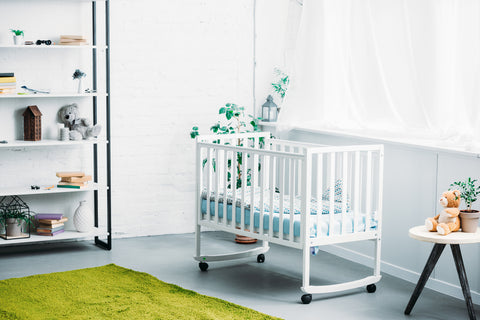
There’s a lot to think about when preparing to welcome a new baby into your family! One of the biggest decisions is deciding where your little one will sleep. Whether you choose a baby cradle, crib, or bassinet, safety is your top priority.
If you’re opting for a cradle, you’re in the right place! Here at Newton Baby, we’re passionate about sleep safety for your precious bundle of joy!
In this article, we’ll go over what to look for when it comes to choosing the safest cradle; what elements matter the most for keeping your baby comfortable, calm, and safe; and what should (and shouldn’t!) go in the crib with your little one.
Since the differences between cradles, bassinets, and cribs can be a little confusing, let’s start there before we talk about choosing a cradle.
The Differences Between Cribs, Bassinets, And Baby Cradles
Cribs
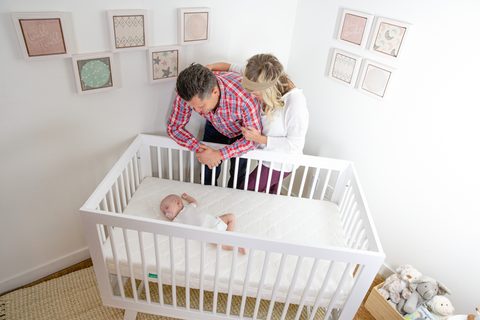
Cribs are what you typically see in a nursery. They usually have wooden or metal slats on the sides and are bigger than both bassinets and cradles.
If you’ve got your measuring tape out, know that cribs come in two sizes: standard, with the mattress measuring 52" long and 28" wide, as well as mini, with the mattress measuring 38" long and 24" wide.
Because cribs are big, they aren’t made to be moved from room to room. But their size comes with one major advantage: it will be years before your baby grows out of their standard-sized crib!
Since cribs are an investment for the first several years of your baby’s life, you want to focus on quality. Check to make sure the materials of your baby’s crib are sturdy, safe, and durable.
For example, some cribs are designed with a trundle drawer to support the mattress structure. Before buying, always be sure to inspect if the drawers open and close smoothly.
Additionally, check if the bottom of the drawer is sturdy enough. Does it have a thin, cardboard insert that might bend under the weight of baby clothes? Or is it made of the same thick material as the rest of the crib?
These are quality checks you may want to consider!
Bassinets
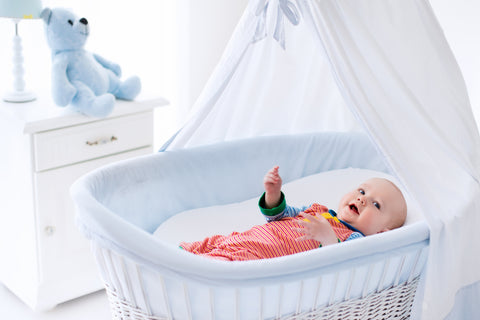
Bassinets are smaller than cribs and designed to be moved easily and fit into small spaces.
They often have wheels, a hood or canopy, and mesh or wicker sides. Some are even equipped with technology that plays music or makes the bassinet rock.
The pro of its small size is that a bassinet will fit nicely in your bedroom, making it easy to have your baby sleep in your room (but not in your bed!) for the first few months.
Since the Centers for Disease Control and Prevention (CDC) recommends that babies sleep in the same room as their parents for at least the first few months of life, a bassinet might be a great option if your master bedroom is tight on space.
Even if your space is big enough for a crib, you may benefit from the portability of bassinets. You can move the bassinet around the house to keep your baby nearby no matter the time of day (or night!).
Bassinets are also easier for you to lean over and grab your little one from if they need to be cuddled after waking in the middle of the night.
All of that said, the con of the small size of a bassinet is that your little one will quickly outgrow it! Babies typically become too big for a bassinet by the time they’re four months old, if not earlier.
Still, if you prefer to have your baby sleep in a bassinet for the first few months of their life, that’s perfectly OK!
They can sleep just as safely and soundly in a bassinet as they would in a crib. Just be sure to keep it clear of any extra bedding. Your baby can always upgrade to a crib when they (and you!) are ready.
Cradles
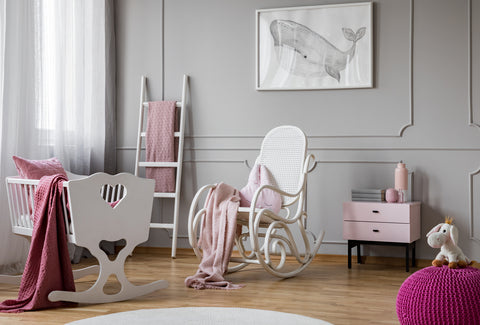
Cradles are a bit more of a throwback!
You might have an heirloom cradle handed down from your parents or grandparents. They usually have wooden slats on the sides and rock or glide back and forth.
They’re similar to bassinets because they’re a temporary bed for your little one and usually more portable than a crib. Baby cradles are smaller than a crib but might be bigger than a bassinet.
Depending on the size and design of the cradle, you will probably need to move your baby from their cradle to their crib when they’re around four months old or when they start rolling over.
That being said, there are several safety considerations to take into account no matter where your baby is sleeping. In this article, we’ll focus on safety tips for baby cradles.
How To Choose The Safest Baby Cradle
1) Buy A New Baby Cradle
If you have your mom or dad’s cradle in your attic and are hoping to use it for your own little one, you might want to think again.
Heirlooms are special and hand-me-downs can save a lot of money, but there are a few baby items you should always buy new. Your baby’s bed is one of them.
In order to ensure your little one is getting a top-notch cradle tested with the highest safety standards, it’s always best to buy the newest version available.
You never know what sort of wear and tear used baby beds have gone through when you buy them online (or borrow them from a friend!).
Whether you’re purchasing a cradle, crib, or bassinet, stick with a brand-new one that meets current safety standards and has all of its parts intact. Your baby will sleep better for it and you will, too.
2) Opt For Breathability
No matter what your baby is sleeping in, opt for breathability when it comes to the mattress as well as the sides of the cradle or crib. Most cradles have wooden slats on the sides, which allow for good airflow around your baby.
If your cradle comes with a mattress, you should use it since it’s designed to fit properly into that specific cradle. But if it doesn’t come with a mattress, you’ll need to buy your own.
Tip: When choosing a mattress for the crib your baby will grow into after their cradle, consider Newton Baby’s breathable Crib Mattress!
Our Wovenaire® Core is made of 90% air and 10% food-grade polymer, making it much more breathable than leading organic mattresses.

According to safe sleep guidelines, you should always put your baby to sleep on their back. But with a Newton Baby Crib Mattress, you can rest easy knowing that your little one will be able to breathe straight through the mattress if they happen to roll onto their stomach during the night!
3) Check The Mattress Fit
While we’re on the topic of mattresses, you’ll want to make sure the mattress fits just right inside the cradle.
While you shouldn’t have to stuff the mattress into the cradle to make it fit, there shouldn’t be a large gap between the inside of the baby cradle and the mattress.
The same goes for cribs and crib mattresses as well. If there’s too much of a gap, your little one could get an arm or leg stuck. As a rule, when the mattress is inside the crib, you should not be able to fit more than two fingers between it and the crib frame.
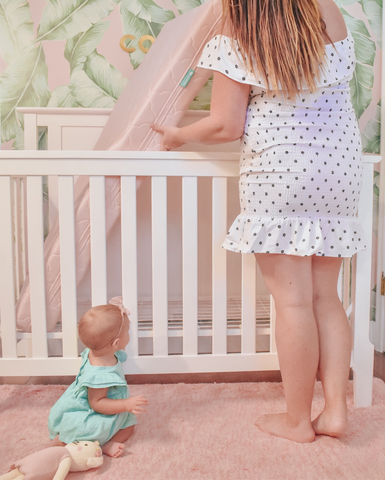
4) Avoid Off-Gassing
If you’re not familiar with “off-gassing,” you’re probably not the only one. Many people don’t know what it is, but it happens in all of our homes!
Off-gassing is what happens when manufactured items release chemicals and volatile organic compounds (VOCs) into the air. Breathing in those chemicals can cause irritation, health conditions, and even some serious diseases.
If possible, choose a cradle mattress that has low chemical emissions. How can you know that? Look for a Greenguard Certification.
The Greenguard Certification Program tests the chemical emission of all sorts of products (not just mattresses!). That makes it easier for you as a buyer to know which products have low chemical emission and won’t expose your family to VOCs.
When it comes to picking a safe crib mattress later on, look no further than Newton’s Crib Mattress! Our mattress is independently tested and certified for low chemical emissions to Greenguard's Gold Standard.
For more information on off-gassing, check out our full article here.
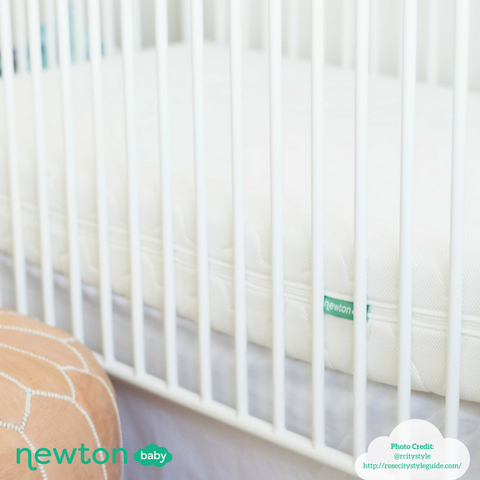
5) Choose A Sturdy Baby Cradle
Cribs are generally quite solid and sturdy. Bassinets and cradles, on the other hand, are often made to rock or they come with wheels or collapsible legs.
Make sure the cradle you choose is sturdy enough that it won’t tip over easily, even if you bump into it in the middle of the night. You’ll also want to check that the wheels (if your cradle has them) lock securely.
Additionally, take precautions with any baby cradle that rocks.
It can be so nice to rock your precious baby to sleep in their cradle! But the rocking motion can become a safety hazard if it causes your little one to roll to the side of their cradle.
For that reason, never leave your baby unattended while the cradle is still rocking! And choose a cradle that locks to keep it stationary while you’re away.
(This is another reason the adorable, antique cradle you may have received as a hand-me-down might not be the safest option for your baby.)
But that doesn’t mean you can’t use the rocking feature! Just make sure to keep an eye on your little one while you rock them to sleep. Let’s be honest, a baby nuzzled up while sleeping is just too cute to look away from, anyway!
6) Avoid Extra Bedding
The safest way for your baby to sleep is on a firm mattress with a fitted sheet and nothing else! That means no extra bedding, no pillows, no crib bumpers…you get the idea.
Bassinets and cradles sometimes come decked out with extra bedding. You want none of that! When your little one graduates to their crib, the same rule applies — only the mattress and fitted sheet.
We don’t want anything posing a threat to your baby in the middle of the night. Extra bedding, while it might look adorable, could potentially get in the way of your baby’s breathing or movement while they sleep.
If you’re worried about your baby being cold at night, consider using a swaddle (the first few weeks of their life) or a sleep sack. Never use thick quilts, blankets, or other fabrics that lay loosely over your baby.
Your baby will be comfortable and safe with just a clean, fitted sheet atop their mattress.
Our Breathable, Organic Cotton Sheets are soft and perfect to use for your baby’s crib mattress. We’ve got you covered with sheets for mini mattresses as well as standard mattresses and four cute patterns to match your nursery decor!

7) Stay Away From Small Parts
To avoid choking hazards, stay away from baby cradles with small parts that your baby could put in their mouth. You should also check for sharp or pointy parts, especially on the inside walls of the cradle.
Another way to keep choking hazards out of your little one’s bed? Don’t put their baby cradle underneath curtains, blinds, or strings that could find their way into it.
This is where investing in a new, quality cradle will also come in handy!
Vintage or hand-painted cradles may sometimes have rough or flaky exteriors. You’ll want to make sure that the slats of the crib are smooth and have no chipping paint.
We don’t want your precious little one getting ahold of any bits of wood or paint and accidentally ingesting them!
8) Keep Your Cradle Set-Up Simple
We already mentioned keeping those adorable blankets and stuffed animals outside of your baby’s bed, but it’s important that the cradle is kept simple, too.
Items that might feel fancy for your baby are usually not necessary. Waterbeds, cushiony inserts, or other items that emphasize comfort over safety can be dangerous for your little one. Always opt for the sturdier, safer option!
That means the vintage cradle you saw online, while adorable, may be better off avoided. Newer cradle models prioritize sturdy, reliable materials and your little one’s safety.
Additionally, although they’re cute, headboards or footboards with decorative cut-outs should also be avoided. Your baby’s arms, legs, fingers, or toes could become trapped in the nooks and crannies.
Opting for a cradle built with smooth materials that prioritizes safety over style is the best choice for giving your little one the sound, safe sleep they’ll need for years to come!
9) Keep Sleep Safety In Mind
Whether you put your little one to sleep in a crib, cradle, or bassinet, there are some basic sleep safety guidelines that every parent should adhere to!
We’ve already mentioned a few of them, like using a firm mattress and checking for the right fit. Other guidelines include:
- putting your baby to sleep on their back (for both nighttime and naps)
- sharing your room, but not your bed, for at least the first six months
Check out our full article on sleep safety for your little one here. At Newton Baby, your precious little one’s sleep safety is our number one priority. We want to offer you the tools to help your baby get the best night’s sleep of their life, every night!
Rockabye Baby
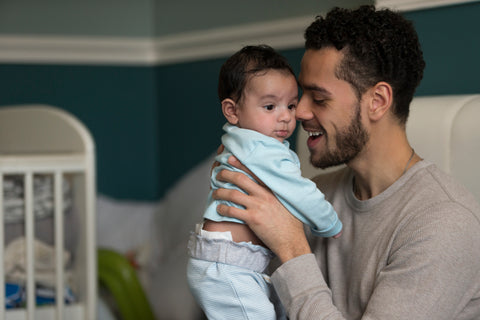
A baby cradle can make it easy for you to have your newborn close by and rock them into a sound sleep at night. Just be sure to look out for your baby’s well-being and choose the safest cradle!
Since your little one will only use a cradle for a few months, remember to keep sleep safety in mind when it comes to your baby’s crib as well. For the most peace of mind, put them to sleep on a breathable Newton Baby Crib Mattress.
Here’s to years of sound, safe sleep for your little one!
